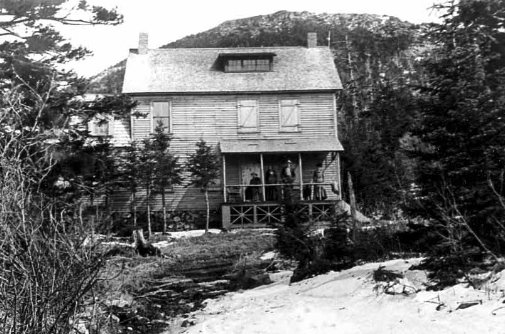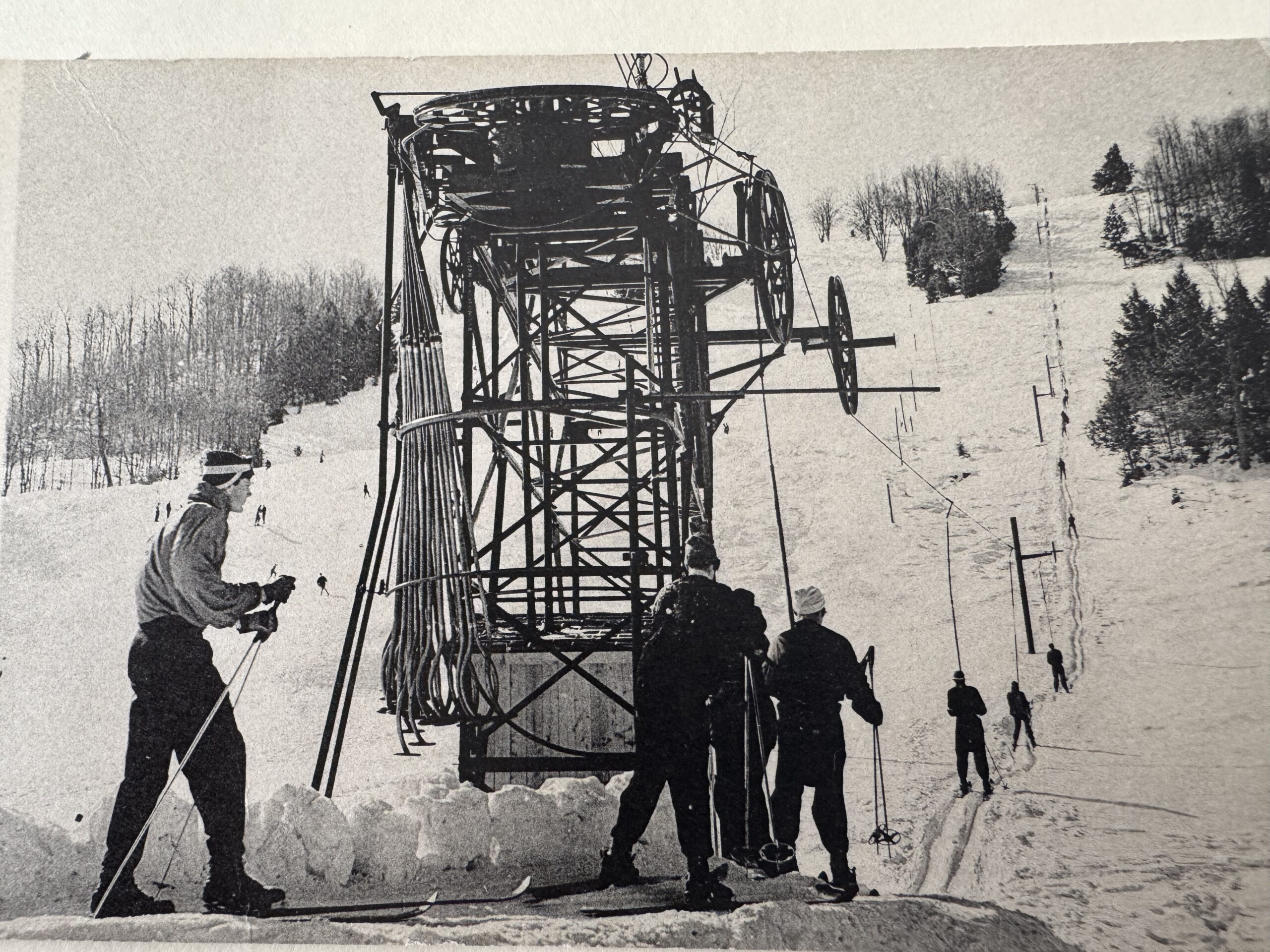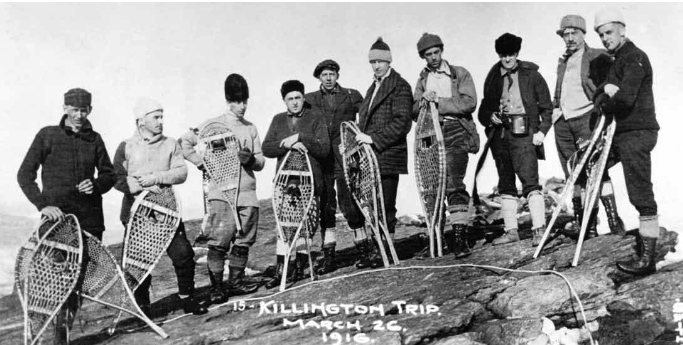By Karen D. Lorentz
Before their use as recreation destinations, the mountains in Vermont presented formidable barriers to travel and trade, especially in the southern half of the state. The unbroken ridge was not as penetrable as the northern half where river valleys traversed the higher peaks. The Green Mountain range cut off the eastern half of the state from the western side. Mountain passes at elevations of 2,000 feet above sea level were difficult to negotiate in the late 1700s and early 1800s, and settlers moved among towns infrequently and only when the weather cooperated. As a result, there were great differences in political, social, commercial, and religious lives of Vermonters.
As more towns were settled, however, more roads were built and as people had reason to cross the mountains, they found ways to do so, although the traveling remained an arduous journey. While the railroad that was planned between Rutland and Woodstock failed to materialize, a stage line did go over Sherburne Pass in the 1800s and afforded a scenic route that was compared to the Swiss Alps!
With the advent of the railroad in 1850 and the beginnings of Vermont tourism ushered in by the famous spas like those at Clarendon and Middletown Springs, more visitors found their way to Vermont.
One of the first settlers to capitalize on the economic benefits of tourism was an enterprising pioneer who discovered mineral springs on his land in Clarendon in the 1770s. He built a large log structure to house guests in 1781 and expanded it to a hotel for 100 guests in 1798. He ran a thriving tourist business by marketing the “therapeutic powers” of the bubbling waters at Clarendon Springs.
There were more than 100 commercial springs in Vermont in the 1800s, 32 of which attracted hotels of varying proportions and amenities. By the 1850s Woodstock, Manchester, Wheelock, Quechee, and Brattleboro were among the better-known locations that attracted a successful mineral-spring hotel business.
Visitors also discovered the delights of sunsets from mountain peaks and the rehabilitative powers of mountain air. Whereas the stagecoach and boat had brought summer people to the lakes and spas, the trains made “mountain trade” possible. Outdoor enthusiasts who enjoyed hiking up tall mountains and basking in fresh mountain air during the nation’s Romantic Period in the 1800s set the scene for the development of hotels on Vermont mountain summits.
Summits as assets
The same men who had once seen mountains as obstacles to commerce had discovered a natural asset. By 1858 Mount Mansfield had a Summit House and soon after a luxurious village hotel, too. The latter combination transformed the town of Stowe from a wilderness to a highly successful recreational mecca!
Other mountain retreats were established throughout the state, including successful summit houses on Mount Equinox in Manchester and Breadloaf in Ripton. Mount Ascutney had a mountain road surveyed by 1857, and in 1858 a large shelter for hikers was built from granite quarried on the mountain.
Towns located near mountains — Woodstock, Montpelier, St. Albans and Manchester — quickly became thriving centers of tourism. Native Vermonters were aware of both the economic benefit and the aesthetic challenge of mountain adventures.
In Rutland there was also an interest in “going up the mountain.” The earliest newspaper articles in the Rutland Herald described horseback excursions to the mountaintop. The first article was entitled “Mt. Killington” and was dated Aug. 18, 1859. Leverett Wilkins of Mendon wrote about building a rough road starting from a gang mill, located in the Wheelerville area of Mendon.
No sooner had the horse path been built than Vincent C. Meyerhoffer built a rustic cabin about 300 feet below Killington Peak where he entertained visitors in the summer.
Rutland waited until 1879 to cash in on Killington. A surveyor with the U.S. Coast and Geodetic Survey had laid out a route to the second highest peak in the state. Delighted with the prospect of a tourist attraction, the citizens of Rutland raised enough money for the construction of a mountain road for horse and carriage travel. They broke all records for building mountain roads, seeing it to completion that same season (1879).
Vying with spokesmen for Mount Mansfield, the publicists for Killington advertised “a fine road leading east from the village” and a view from the top “far surpassing in extent and beauty that obtained from any other mountain in Vermont” and even “regarded more attractive than that from Mount Washington, being less a scene of desolation and of greater pastoral beauty, presenting to the beholder a sea of mountains clothed to their summits with verdure, their sides dotted with nestling lakes and fertile farms.”(Smith and Rann, eds. “History of Rutland County, Vermont,” 1886.)
Playing host to increasing throngs of friends and visitors, Meyerhoffer enlarged his cabin to a hotel, which opened on June 17 for the 1880 season. Killington’s Summit House was more ambitious than the original hotels on either Mansfield or Camel’s Hump with rooms for 30-40 guests.
Other routes to the peak were in use from the eastern side of the mountain including a Juggernaut Trail that led in from West Bridgewater (reportedly following or paralleling a Juggernaut Road built in 1853).
In 1913 a group from Woodstock raised funds to build a trail from West Bridgewater to Killington Peak. (Years later Pres Smith used this route when scouting the mountain.)
Winter catches on
In 1892, the Woodstock Inn opened its doors in winter and entertained visitors with cross-country ski treks; by 1910 they had built a winter sports center with toboggan runs and a ski jump. Vermont colleges sported ski teams and the first rope tow began operations Jan. 28, 1934 in Woodstock. By 1941, there were reportedly 50 tows across Vermont.
As a small-town trend was developing for winter use of the hills, Perry H. Merrill, the state forester who eventually became the commissioner of forests and parks, saw an economic benefit to the new sport and obtained Killington Peak for the state. He tried to promote his Killington idea to businessmen in Rutland in 1941 but was not successful, as they were aware of the challenges facing Pico.
The lack of access to Killington Peak further discouraged any interest.
World War II halted Merrill’s ski-area promoting. But in 1951 he sent forester Charles Lord and highway engineer Abner W. Coleman to survey Killington. They pronounced it “fit for skiing,” but still Merrill couldn’t persuade anyone to develop the mountain.
The key ingredient of a good mountain was there along with nearby places that had catered to tourists and could now host winter guests.
Next week we’ll meet the person who saw—and capitalized—on that potential latent in The Beast. Part 2.

Courtesy Vermont Historical Society
The first known Killington House in the late 1800s.

Courtesy Vermont Historical Society
Hikers summit in the1900s.




